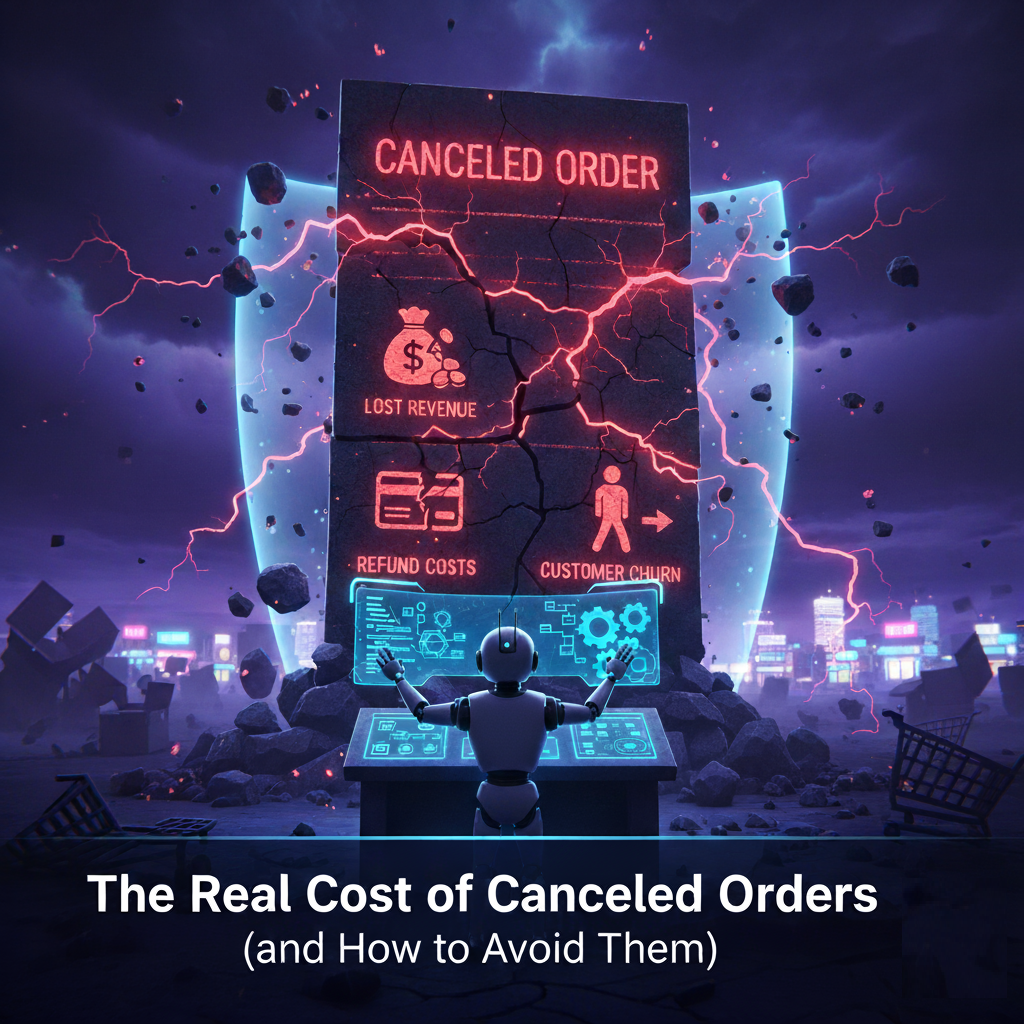Unforeseen order cancellations are one of the most significant yet often underestimated drains on profitability for any enterprise utilizing an Ecommerce Automation model.
It is essential to understand the full financial and operational impact of a canceled order.
This understanding is the first step toward preserving revenue and elevating your customer experience.
This article, presented by Quixess Ecommerce Automation, will meticulously examine the true expenses associated with cancellations.
We will then illustrate how robust automation, particularly in inventory management and e-commerce integrated customer service, provides the definitive solution.
Consequently, you will be able to stop money from leaking out of your business.
The Financial Impact: Unpacking the Hidden Costs of Order Cancellation
A canceled order may seem like a simple zero-sum transaction. It looks like no sale was made and no money was lost. However, this is an illusion.
It is an established fact that canceled orders incur substantial operational costs. These costs have already been expended by your business. They cannot be recovered.
These financial burdens are typically categorized into both tangible and intangible costs. They effectively erode your net profitability. Therefore, you must recognize these costs.
Tangible Costs: Money Already Spent
These are the immediate, measurable expenses. They cannot be recovered even after the order is terminated.
It is imperative that these costs be accounted for when calculating your true loss. This ensures accurate financial tracking.
- Customer Acquisition Cost (CAC): This represents the initial expenditure on marketing and advertising. This money was spent to persuade a customer to place an order. Consequently, this includes the money paid for campaigns on social media and other digital channels. This cost is non-refundable. The marketing effort has already been completed. This cost remains even if the customer cancels. This is a primary expense in the modern ecommerce platform environment. If your cost to acquire one customer is $15, that $15 is permanently lost for every canceled order. This financial reality underscores the need for effective Ecommerce Automation to secure those hard-won conversions.
- Payment Processing Fees: Financial services providers and payment gateways charge a fee for processing a transaction. This is a normal business cost. In many instances, the full transaction fee is not refunded when an order is canceled. This lost money is a concrete expense of the canceled transaction. It is a direct hit to your profit margin.
- Labor and Operational Costs: Various resources and personnel hours are often allocated before an order is officially canceled. For example, warehouse staff may have started the picking and packaging of the product. This activity is rendered fruitless by a subsequent cancellation. The labor associated with processing the refund is also a cost. Furthermore, the time spent returning the item to stock is another expense. These operational costs are a clear detractor from profit. They are a form of wasted effort.
- Inventory Disruption Costs: A canceled order can temporarily freeze stock availability. This is especially true for items that are in high demand. This disruption can cause issues with your real-time inventory count. Thus, it can potentially lead to an oversell to another customer. This secondary oversell creates another cancellation. This is why tools offering full social commerce integration are essential for accurate inventory tracking.
Intangible Costs: The Damage to Brand Equity
The intangible costs are less quantifiable. However, they pose a far more profound and long-term threat to your enterprise.
These impacts fundamentally compromise customer lifetime value (CLV). They hurt your brand’s reputation.
- Customer Dissatisfaction and Churn: A negative cancellation experience is very damaging. This is particularly true if the cancellation was caused by a business error like overselling. Therefore, this experience irrevocably damages the customer relationship. This is a direct challenge to the importance of customer service in ecommerce. A dissatisfied customer will likely defect to a competitor.
- Negative Word-of-Mouth: A customer who had a poor experience is very likely to share their frustration. They often share this across online forums and social media. This detrimental feedback diminishes trust. It actively hinders the acquisition of new customers. In essence, the cost multiplies as you lose future sales.
- Decreased Customer Lifetime Value (CLV): A canceled order is not simply one single lost sale. It is the entire future revenue stream from that customer that is permanently curtailed. Retention of customers is demonstrably more cost-effective than acquisition. This makes the loss strategically critical. Your focus should always be on long-term value.
Primary Causes: Why Orders Are Canceled in the E-commerce Landscape
A comprehensive analysis of cancellation data reveals that the reasons are primarily concentrated in two categories.
These are inventory mismanagement and deficiencies in customer service in e commerce.
Targeted improvements in these areas offer the highest potential for reduction in cancellations.
This improvement is best achieved through advanced Ecommerce Automation.
1. Stock Issues and Overselling
This is arguably the most detrimental reason for a business-initiated cancellation. It is profoundly damaging to customer faith. It signals poor organization.
- The Overselling Problem: An oversell occurs when a customer purchases a product that is, in fact, out of stock. You cannot fulfill the order. This problem is particularly prevalent for ecommerce platforms that sell across multiple channels. These channels include the main website, marketplaces, and social media. This happens when the channels lack a unified inventory management system.
- The Inventory Discrepancy: Disparities often arise between the stock level displayed on the storefront and the actual physical quantity in the warehouse. This is a fundamental breakdown in data synchronization. Consequently, it necessitates the development of sophisticated Ecommerce Automation tools.
- Print-on-Demand Complications: Even for print on demand websites, cancellations can occur. This happens if the supply chain for blank products or printing capacity is not accurately tracked. This results in a system-generated stockout. The customer ordered an item you cannot make.
2. Customer-Initiated Issues
Customers cancel orders for numerous reasons. These reasons are often connected to a lack of transparency or slow processing within the ecommerce platform experience.
Addressing these issues is vital for the importance of customer service in ecommerce.
- High or Unexpected Shipping Costs: Many shoppers abandon their purchase at the final stage. This happens when additional shipping fees are suddenly disclosed. This lack of transparency is a major catalyst for abandonment. Therefore, transparent pricing must be a priority.
- Extended or Ambiguous Delivery Times: In the current era of instant gratification, customers expect quick service. Prolonged fulfillment windows or the absence of a firm delivery date frequently lead customers to annul their purchase. They seek a quicker supplier. Quick, clear communication is essential.
- Buyer’s Remorse or Change of Mind: This can sometimes be unavoidable. However, this type of cancellation often results from a confusing purchase process. It can also be caused by the customer being unable to easily modify their order. For example, they might want to change a size or color. Instead of an easy change, they must initiate a full cancellation and re-purchase. Thus, flexibility reduces cancellations.
The Automation Solution: Quixess’s Strategic Framework
Mitigating the high costs of cancellations requires a unified, intelligent approach. This approach must leverage the power of Ecommerce Automation.
Quixess specializes in implementing the necessary technological infrastructure. We help you preempt cancellations before they can even occur.
This is accomplished through superior inventory synchronization. It is also achieved through an enhanced approach to e-commerce integrated customer service.
Pillar 1: Perfecting Inventory with Real-Time Synchronization
The most effective method for eradicating cancellations due to stock issues is robust inventory management. You must deploy a centralized, intelligent inventory solution.
These systems ensure that all sales channels are consistently and simultaneously updated. They show the current stock availability.
In essence, the central principle is to never sell a product that is not physically present in your warehouse.
Top-Tier Automation Tools for Inventory and Order Sync
Implementing one of these specialized systems will seamlessly integrate with your existing ecommerce platforms (like Shopify or BigCommerce).
This eliminates the operational risk of overselling.
- Cin7: This is an omnichannel powerhouse. Cin7 (formerly DEAR Systems) is recognized for its advanced capabilities. It supports complex workflows, manufacturing, and multi-warehouse operations. Its scalability is paramount for rapidly expanding enterprises.
- QuickBooks Commerce: This is a good solution for businesses that are heavily reliant on QuickBooks for their accounting processes. This tool provides a powerful combination of inventory management and financial tracking. Furthermore, this is especially advantageous for wholesale and B2B-focused models.
- Zoho Inventory: This solution is highly cost-effective and scalable. Zoho Inventory is valued for its multi-channel synchronization features. It also connects seamlessly with other components of the Zoho business ecosystem.
- Finale Inventory: This system is engineered specifically for high-volume merchants. It is also designed for those with warehouse-centric operations. It provides granular control and FBA sync capabilities.
Automation Features for Inventory Management
The use of automation here is critical. It guarantees accuracy and speed, preventing the data gaps that cause oversells. This is what makes Ecommerce Automation so powerful.
- Real-Time Stock Updates: Inventory levels are instantly adjusted across all sales channels. This happens the moment an order is placed. This ensures a true, uniform stock count across your ecommerce platform.
- Demand Forecasting: AI-driven tools utilize historical data and current trends. They predict future demand. This allows them to automate the replenishment process. Consequently, this proactively prevents stockouts from ever happening.
- Minimum Stock Alerts: Automated notifications are automatically triggered. This happens when inventory drops below a pre-determined safety level. This allows your team to act before a critical stockout occurs.
Pillar 2: Elevating Customer Experience with Integrated Service
The second pillar of cancellation avoidance centers on utilizing Ecommerce Automation to provide proactive communication. It also focuses on creating an effortless experience.
When customers feel informed and empowered, they are markedly less likely to cancel their order. This is a core part of good customer service in e commerce.
Best-in-Class Platforms for E-commerce Integrated Customer Service
These e-commerce integrated customer service platforms connect directly to your order data. This allows support agents and automated systems to access critical information instantly.
This greatly enhances the importance of customer service in ecommerce.
- Gorgias: This tool is designed explicitly for e-commerce. Gorgias excels at consolidating customer conversations from all channels. These include email, chat, and social media. It puts them into a single, unified ticket. It provides immediate access to order details. Thus, agents can issue refunds or modify orders without navigating away from the service interface.
- Zendesk: This is an enterprise-level solution. It offers extensive customization and scalability. It is an ideal choice for larger organizations. These organizations require a sophisticated, multi-layered support infrastructure.
- Help Scout: Help Scout is known for its user-friendly shared inbox and robust help center features. It integrates with major ecommerce platforms like Shopify. This enables agents to view order history and fulfillment status right alongside the customer conversation.
Automation for Customer Service and Retention
The use of Ecommerce Automation within customer service fundamentally shifts the business. It moves the business from a reactive to a proactive communication model.
This prevents customers from having to ask for updates.
- Proactive Shipping Updates: This automation reduces cancellations due to long wait times. The system sends automated SMS or email alerts for “Order Confirmed,” “Shipped,” and “Out for Delivery.” The status of the order is consistently communicated to the customer.
- Self-Service Portals: This feature reduces the customer service agent load. It also empowers customers. The system provides an automated knowledge base, AI chatbots, and an easy-to-use customer portal. Shoppers can check their order status or initiate a modification request without human intervention.
- Pre-Cancelation Intervention: This strategy saves orders right as the customer attempts to cancel. When a customer clicks a “cancel” option, an automated window is triggered. It offers a viable alternative, such as a discount code or an offer for priority shipping. This intervention can change their mind.
- Transparent Pricing: This automation strategy mitigates abandonment due to unexpected costs. The integrated service platform displays transparent messaging. This is done early in the purchase journey. It clearly communicates all shipping and handling charges before the final step.
Pillar 3: Optimizing the Customer Journey on Your E-commerce Platform
A seamless shopping experience is a critical component of cancellation prevention. This experience must be smooth from browsing to checkout.
A simplified and transparent process builds the confidence required for a customer to complete their transaction.
- Streamlining the Checkout Process: A complex, multi-page checkout is a primary cause of cart abandonment. The use of automation tools can help implement a one-page checkout. It can also integrate multiple payment options. These include options like Apple Pay or Google Pay. This creates frictionless purchasing. This is especially vital for businesses selling across different ecommerce platforms.
- High-Quality Product Information: Inaccurate descriptions or poor-quality visuals lead directly to post-purchase cancellations. This happens in the form of returns. The received product did not meet the customer’s initial expectations. Automation can ensure that detailed sizing guides and customer reviews are consistently displayed.
- Social Commerce Integration: Sales are increasingly moving to platforms like Instagram and Facebook. It is therefore imperative that your product listings and inventory remain synchronized across these social commerce channels. Thus, this prevents overselling in a high-volume, dynamic environment.
Quixess: Your Partner in Ecommerce Automation
The financial and reputational damage caused by canceled orders is a serious threat. It harms the longevity and profitability of any e-commerce enterprise.
The solution is not to simply manage cancellations. Instead, the goal is to prevent them entirely. This is achieved through the calculated implementation of Ecommerce Automation.
Quixess offers a comprehensive suite of automation solutions. These are meticulously designed to integrate with your existing ecommerce platform and systems.
We effectively eliminate the operational friction points that result in a negative customer experience.
By synchronizing your inventory in real-time and establishing a sophisticated e-commerce integrated customer service framework, your business can significantly reduce its cancellation rate.
This allows you to reclaim lost revenue and enhance customer loyalty.
It is absolutely crucial that the modern business recognize this fact. Investing in automation is not an optional expense.
Conversely, it is an indispensable strategic requirement for sustainable profitability. The time has come to stop absorbing the hidden costs of cancellations.
Implement a powerful Ecommerce Automation strategy today. Watch your retention rates, operational efficiency, and overall profits rise dramatically.
The power of Ecommerce Automation will transform your business.
The Ultimate Advantage of Ecommerce Automation
In the fast-paced world of online retail, customer expectation is non-negotiable. They expect speed, accuracy, and clear communication.
The moment a business fails to meet these expectations, a cancellation often occurs.
This cancellation carries a heavy, hidden financial cost that spans marketing, logistics, and customer service.
The Quixess blueprint for success relies entirely on preventative Ecommerce Automation.
By utilizing a top-tier ecommerce platform and integrating powerful inventory sync tools, you can ensure that overselling—the deadliest cancellation cause—is eliminated.
Furthermore, when you combine this with proactive, integrated customer service, you turn potential cancellations into opportunities for trust and retention.
This seamless, automated process protects your revenue, builds your brand’s reputation, and secures your long-term growth.
Conclusion
Embracing intelligent Ecommerce Automation is the single best way to protect your business.
Ready to stop losing money to preventable cancellations?
Stop letting inventory errors and slow support erode your profits. Click here to consult with a Quixess automation expert and begin calculating the definitive cost of your cancellations.
Start your journey toward implementing an intelligent Ecommerce Automation solution and secure your future revenue now!


